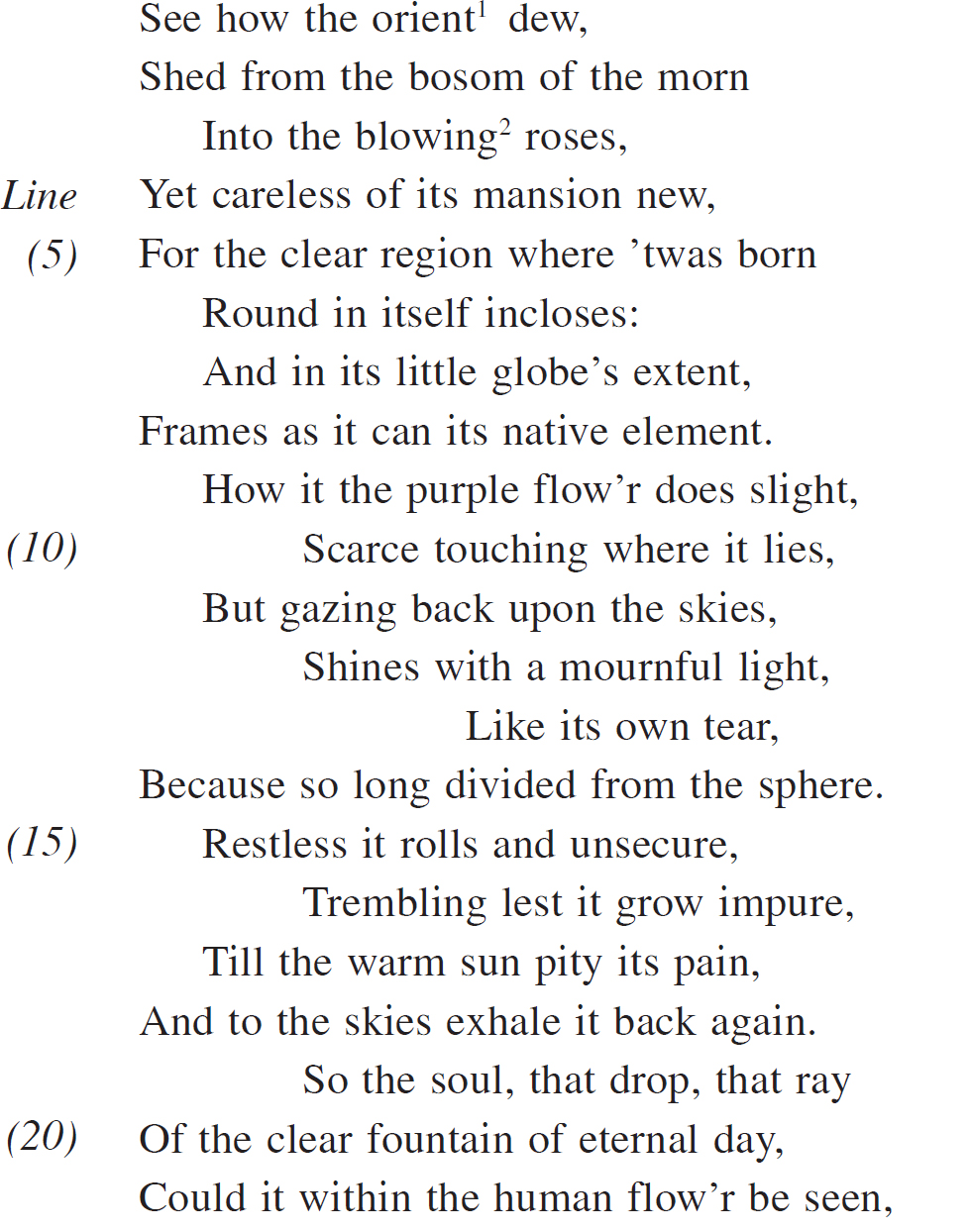
1 pearly, sparkling
2 blooming
Answering multiple-choice questions about poetry passages involves many of the same principles as does answering questions about prose. There are some differences, however.
First, the poetry passages tend to contain more questions that rely on knowledge than the prose passages. You will certainly see a question or two on the literary devices (for example, personification or metaphor) in the poem. You might see a question about the way a line scans or what the rhyme scheme is called, but these are nothing to worry about: Recent tests have not included a single question on scansion or the names of classical poetic forms. The test writers do, however, like to use poetry for questions about grammar, because poets use the kind of tangled syntax that makes for challenging grammar questions.
Second, the poetry you’ll see on the AP Exam tends to make for harder reading than the prose passages. Hard, but not impossible. There’s a certain style of poetry that tends to appear on the AP English Lit Exam. In order to write questions properly, the test writers are limited in the kind of material they can use. As a result, you won’t see poems that stretch language and meaning to its limits, or poems that are open to such a variety of interpretations that asking meaningful multiple-choice questions about them is too difficult. Nor will you see beautiful and elegant but direct and simple poems. Also, you won’t see any especially “out there” or experimental postmodern poetry on the exam. The AP Exam generally features poems of 30 to 70 lines that use difficult language to make a precise point. The poem below and the questions that follow should give you a good idea of what to expect on the test. This is an excellent place to practice what you’ve learned in previous chapters. For even more practice, work through the two poetry drills and the bonus questions at the end of this chapter.
Use all of the techniques we’ve taught you.
Read the poem as prose.
Focus on the main idea.
When answering the questions, use POE and Consistency of Answers.
Be sure to read before and after line references.
Read the following poem carefully and choose answers to the questions that follow.

1 pearly, sparkling
2 blooming

3 modest
1. The overall content of the poem can best be described by which statement?
(A) The characteristics of a drop of dew are related to those of the human soul.
(B) The life cycle of a drop of dew is contemplated.
(C) The human soul is shown to be a drop of dew.
(D) The physical characteristics of a drop of dew are analyzed.
(E) The poet offers a mystical vision of a drop of dew as a spiritual entity that has all the qualities of the human soul.
2. The poem contains
I. a biblical allusion
II. an extended metaphor
III. an evocation of spiritual longing
(A) I only
(B) II only
(C) III only
(D) I and II only
(E) I, II, and III
3. In context, “careless of its mansion new” (line 4) most nearly means
(A) the dew drop does not understand the value of its beautiful surroundings
(B) the dew drop does not assist the flower in any way
(C) the dew drop is unconcerned with its beautiful surroundings
(D) the human soul does not value the body
(E) the human soul does not take part in the care of the body
4. The speaker’s metaphor for the human body is
(A) “the orient dew” (line 1)
(B) “the sphere” (line 14)
(C) “the clear fountain” (line 20)
(D) “the sweet leaves and blossoms green” (lines 23–24)
(E) “th’ almighty sun” (line 42)
5. Which of the following is the antecedent of “its” in “Does, in its pure and circling thoughts, express” (lines 26–27)?
(A) “soul” (line 19)
(B) “day” (line 20)
(C) “flow’r” (line 21)
(D) “height” (line 22)
(E) “leaves” (line 23)
6. All of the following aspects of the dew drop are emphasized in the poem EXCEPT
(A) its disregard for the physical world
(B) its desire to regain the heavens
(C) its purity
(D) its will to live
(E) its roundness
7. Lines 9–14 suggest the drop of dew is
(A) frightened of death
(B) full of unhappy longing
(C) envious of the rose’s vitality
(D) part of a larger body of water in the sky
(E) uncertain of the future
8. Lines 19–28 make explicit
(A) the analogy between the drop of dew and the soul
(B) the actual differences between the drop of dew and the soul
(C) the true nature of the drop of dew
(D) the soul’s need for the body
(E) the soul’s thoughts
9. Each of the following pairs of phrases refers to the same action, object, or concept EXCEPT
(A) “mansion new” (line 4)…“purple flow’r” (line 9)
(B) “globe’s extent” (line 7)…“the sphere” (line 14)
(C) “that drop” (line 19)…“that ray” (line 19)
(D) “exhale” (line 18)…“dissolving” (line 41)
(E) “Every way it turns away” (line 30)…“It all about does upwards bend” (line 38)
10. Which of the following best paraphrases the meaning in context of “So the world excluding round,/yet receiving in the day” (lines 31–32)?
(A) Although the dew drop evaporates in the sun, it arrives anew each day.
(B) The world evaporates the drop of dew when it receives the light of the sun.
(C) The dew drop is impervious to everything but time.
(D) Although the dew drop and the soul shut out the material world, they let in the light of heaven.
(E) The only thing that matters to the dew drop is light.
11. In line 42, the sun is symbolic of
(A) fire
(B) rebirth
(C) the soul
(D) God
(E) time
12. Which of the following sets of adjectives is best suited to describing the poem’s tone?
(A) Mysterious, moody, and spiritual
(B) Pious, proper, and academic
(C) Intricate, delicate, and worshipful
(D) Witty, clever, and ironic
(E) Straightforward, impassioned, and sincere
13. In the final four lines of the poem, the poet suggests that
(A) the dew drop will ultimately be destroyed by the sun
(B) the cycle of life and death is continual
(C) the dew drop will return to earth in the form of “manna”
(D) souls as pure as a drop of dew will ascend to heaven
(E) death brings spiritual unity with God
14. Which of the following adjectives is LEAST important to the poem’s theme?
(A) “blowing” (line 3)
(B) “clear” (line 20)
(C) “pure” (line 26)
(D) “bright” (line 33)
(E) “loose” (line 35)
This poem is challenging but absolutely typical of what you will find on the AP Exam. Marvell (1621–1678) was one of the metaphysical poets (check your overview of literary movements), and the previous poem is an excellent example of this school of poetry’s verse. The metaphysical poets were a loosely connected group of seventeenth-century poets who fashioned a type of elaborately clever, often witty verse that has a decidedly intellectual twist to it. The metaphysical poets are noted for taking a comparison—for example, “a drop of dew is like the soul”—and developing it over dozens of lines. Lots of metaphysical poetry appears on the multiple-choice section, not because metaphysical poetry is necessarily great but because unlike most poetry, it lends itself well to multiple-choice questions. So, reading any of the metaphysicals’ poetry is great practice for the AP Exam.

1. The overall content of the poem can best be described by which statement?
(A) The characteristics of a drop of dew are related to those of the human soul.
(B) The life cycle of a drop of dew is contemplated.
(C) The human soul is shown to be a drop of dew.
(D) The physical characteristics of a drop of dew are analyzed.
(E) The poet offers a mystical vision of a drop of dew as a spiritual entity that has all the qualities of the human soul.
Here’s How to Crack It
This is a main-idea question. Remember, you could have left it alone and come back to it if you hadn’t found the main idea yet, but chances are you didn’t have too much trouble. If you had any trouble eliminating choices, it was probably with (C). Does the poet really show that the human soul is a drop of dew? No. Marvell uses a drop of dew to speak about the human soul, but he isn’t suggesting that a person’s inner spirit is actually composed of condensed water. In fact, in the poem the drop of dew isn’t so much a water droplet as it is a receptacle for light. This point becomes important in later questions. You should have eliminated (B) on the premise that it is much too literal to be correct; you’re looking for the deeper main idea of the poem. If (D) threw you, then you weren’t paying attention to the word physical. You should have asked yourself, “Wait a minute, this dew drop trembles with fear at the thought of becoming impure: Can I call that a physical analysis?” Marvell’s drop of dew is a being with a personality and desires; all of these things are studied, not just its physical characteristics. Although (E) looks good at first glance, there’s no way to prove that the author is offering a “mystical” vision. Choice (A) is similar in concept but without any added stuff to throw you off, so it’s the best answer.


2. The poem contains
I. a biblical allusion
II. an extended metaphor
III. an evocation of spiritual longing
(A) I only
(B) II only
(C) III only
(D) I and II only
(E) I, II, and III
Here’s How to Crack It
Question 2 is one of the notorious Roman numeral questions. Remember to use POE and work from the easiest point to the most difficult. You should see that (II) is found in the passage: The dew drop is an extended metaphor for the human soul. An extended metaphor is also known as a conceit, appearing frequently in metaphysical poems. You can eliminate (A) and (C); they don’t include (II).
Item (III) might send you back to the poem, where lines 11–13 (“But gazing back upon the skies,/Shines with a mournful light,/Like its own tear”) should convince you that (III) is a keeper. Eliminate (B) and (D). You’re finished.
Only (E) is left. If you’re curious about (I), the biblical allusion is the word manna, which refers to a kind of bread that came to the starving Israelites from out of heaven. If you had any doubts about (I) or (III) you might have reasoned that both points are consistent with the main idea and should be kept. The correct answer is (E).


3. In context, “careless of its mansion new” (line 4) most nearly means
(A) the dew drop does not understand the value of its beautiful surroundings
(B) the dew drop does not assist the flower in any way
(C) the dew drop is unconcerned with its beautiful surroundings
(D) the human soul does not value the body
(E) the human soul does not take part in the care of the body
Here’s How to Crack It
Question 3 is a straightforward line-reference question. After reading around the line reference, you can easily eliminate (D) and (E). The line in question discusses only the dew drop upon a rose petal. It does not refer to the human soul. Of the remaining choices, (A) and (B) both imply that in context, “careless” means that the dew drop does not take care of the rose, which is simply a misreading. Chances are you didn’t have much trouble on this question. The correct answer is (C).


4. The speaker’s metaphor for the human body is
(A) “the orient dew” (line 1)
(B) “the sphere” (line 14)
(C) “the clear fountain” (line 20)
(D) “the sweet leaves and blossoms green” (lines 23–24)
(E) “th’ almighty sun” (line 42)
Here’s How to Crack It
To answer this question you must either trace Marvell’s involved metaphor, noting that in lines 19–21 he describes the soul as being housed within the “human flow’r,” or use POE. All four incorrect answers refer to either a spiritual entity (the dew) or its source (the sphere, fountain, and sun) and so can be eliminated. The correct answer is (D).


5. Which of the following is the antecedent of “its” in “Does, in its pure and circling thoughts, express” (lines 26–27)?
(A) “soul” (line 19)
(B) “day” (line 20)
(C) “flow’r” (line 21)
(D) “height” (line 22)
(E) “leaves” (line 23)
Here’s How to Crack It
Question 5 is a typical grammar question and hinges on your knowing the term antecedent. That term, and other grammatical terms you need for the test, can be found in the glossary. By asking for the antecedent, the question is simply asking what the word its stands for in the given phrase. Analyzed grammatically, the only correct usage (and you’ll only be asked about correct usage) is the soul. You might also have reasoned, “For which of the choices would it make sense to have ‘pure and circling thoughts’?” Only (A) makes sense.


6. All of the following aspects of the dew drop are emphasized in the poem EXCEPT
(A) its disregard for the physical world
(B) its desire to regain the heavens
(C) its purity
(D) its will to live
(E) its roundness
Here’s How to Crack It
Question 6 is an EXCEPT question. An excellent way to proceed is to disregard the EXCEPT; cross EXCEPT out.
Eliminate any choice that fits the remaining question, which now reads: All [Which] of the following aspects of the drop of dew are emphasized in the poem.
To do this you must refer back to the passage. Remember: Never work from memory! “Careless of its mansion new” lets you eliminate (A). “Like its own tear/Because so long divided from the sphere” takes care of (B). “Trembling lest it grows impure” lets you eliminate (C). The dew drop’s roundness is emphasized in several places; (E) was easy to eliminate. This leaves only (D), which is the correct answer.


7. Lines 9–14 suggest the drop of dew is
(A) frightened of death
(B) full of unhappy longing
(C) envious of the rose’s vitality
(D) part of a larger body of water in the sky
(E) uncertain of the future
Here’s How to Crack It
Question 7 is a line-reference question that tests your comprehension of a set of lines. If you had trouble with this question you should practice reading poetry for comprehension. You can eliminate (C) and (E) easily as they have nothing to do with the poem. The other choices can almost be justified from the poem, but almost means wrong. Choice (A) could be eliminated because of the word frightened. The drop of dew is perhaps frightened of earthly life (remember, it “trembles” at the thought of becoming “impure”) but as a metaphor for the soul, it is not afraid of death. Certainly no such statement can be found in the poem. Choice (D) is incorrect because Marvell treats the dew drop not only as water, but as a container of light and as a metaphor for the soul. For Marvell the drop comes from the sky, not a body of water in the sky. The correct answer is (B).


8. Lines 19–28 make explicit
(A) the analogy between the drop of dew and the soul
(B) the actual differences between the drop of dew and the soul
(C) the true nature of the drop of dew
(D) the soul’s need for the body
(E) the soul’s thoughts
Here’s How to Crack It
The key here is to understand the question. When something is made explicit, it is stated or spelled out. Explicit is the opposite of implicit. Your task is to see what lines 19–28 show clearly. Using POE, you should eliminate (D) immediately; it only talks about the drop of dew whereas the lines in question refer primarily to the human soul. Choice (E) is a trap answer. The lines in question do refer to the soul’s thoughts, but they do not spell them out; the thoughts are not made explicit. Choice (C) is similarly wrong: The drop of dew’s “true nature” is not the subject of these lines; only the similarity of the drop of dew and the soul is. Choice (B) talks about differences between the soul and the drop of dew. This answer choice is the exact opposite of the lines’ intent. They discuss the similarities of the drop and the soul. In fact, they make the analogy between the drop of dew and the soul explicit—therefore, (A) is the correct answer.


9. Each of the following pairs of phrases refers to the same action, object, or concept EXCEPT
(A) “mansion new” (line 4)…“purple flow’r” (line 9)
(B) “globe’s extent” (line 7)…“the sphere” (line 14)
(C) “that drop” (line 19)…“that ray” (line 19)
(D) “exhale” (line 18)…“dissolving” (line 41)
(E) “Every way it turns away” (line 30)…“It all about does upward bend” (line 38)
Here’s How to Crack It
This is another EXCEPT question, which are common on the exam. Cross out EXCEPT and eliminate answers that satisfy the remaining statement: Each of the following pairs of phrases refers to the same action, object, or concept. Use POE. In (A), “mansion new” and “purple flow’r” both refer to the rose the drop of dew perches on. Eliminate it. In (C), “that drop” and “that ray” seem to refer to different things but both in fact refer to the soul—so eliminate (C). In (D), “exhale” and “dissolving” both refer to the process by which the drop of dew vanishes (evaporation, if you want to be scientific about it). In (B), “globe’s extent” and “sphere” seem to both refer to the dew drop, but in fact, the sphere refers to the skies above—the “heavenly sphere.” Thus, (B) is the correct answer.
Nitpicky? Maybe, but this question is an excellent example of the kind of careful reading you’ll be called upon to do on the actual test.


10. Which of the following best paraphrases the meaning in context of “So the world excluding round,/yet receiving in the day” (lines 31–32)?
(A) Although the dew drop evaporates in the sun, it arrives anew each day.
(B) The world evaporates the drop of dew when it receives the light of the sun.
(C) The dew drop is impervious to everything but time.
(D) Although the dew drop and the soul shut out the material world, they let in the light of heaven.
(E) The only thing that matters to the dew drop is light.
Here’s How to Crack It
This kind of comprehension question is probably the most common type of poetry question on the AP Exam. In essence, you’ll be given a line and asked to answer the question, “So, what does it mean?” As always, read around the line and then use POE. Paraphrase “the world excluding round” as “the drop that turns away from the world” and you can eliminate (A), (B), and (E). None of those choices include that idea. Choice (C) mentions that the drop of dew is impervious. That isn’t a good paraphrase of “world excluding round,” and you can eliminate it with confidence by reasoning that time is not mentioned in the lines in question at all. That leaves only the correct answer, (D).


11. In line 42, the sun is symbolic of
(A) fire
(B) rebirth
(C) the soul
(D) God
(E) time
Different Levels of Difficulty
Get used to the range of difficulty on the AP Exam. Some of the questions are subtle and challenge even the most experienced readers, while others are a piece of cake. Don’t freak out and think you must have missed something when a question seems easy: just collect the point. Don’t miss the easy questions by over-thinking. And don’t worry about missing difficult questions: If those are all you miss, you’re on your way to earning a score of 5.
Here’s How to Crack It
On this question, we hope you saw that the sun symbolized God. The word almighty should have been a big clue. Additionally, metaphysical poets are often concerned with spiritual issues. If you’ve used your overview of literary movements to prepare for this exam, the answer may be even more obvious. The correct answer is (D).


12. Which of the following sets of adjectives is best suited to describing the poem’s tone?
(A) Mysterious, moody, and spiritual
(B) Pious, proper, and academic
(C) Intricate, delicate, and worshipful
(D) Witty, clever, and ironic
(E) Straightforward, impassioned, and sincere
Here’s How to Crack It
This is a tone question. On tone questions, always use POE, and remember that “half bad equals all bad.” Every answer choice has something right in it but only the correct answer choice has nothing wrong in it. In (A), yes, the poem’s tone is spiritual, but is it mysterious and moody? Not really. Eliminate it. Choice (B) has one promising word—pious, as the poem discusses God—but proper and academic do not fit. That isn’t right. Eliminate it. In (D), well, it’s true that the poem is witty and clever, but is it also ironic? Metaphysical poets typically are ironic—that is, hidden messages and contradictions often lurk below the surface of a metaphysical poem’s text, but “On a Drop of Dew” is an exception. Marvell says what he means in a clever way, but not ironically. Choice (E) should just sound wrong. “On a Drop of Dew” is an intensely crafted work, but it is not impassioned nor straightforward. That leaves (C), which sums things up fairly well: intricate, delicate, and worshipful.


13. In the final four lines of the poem, the poet suggests that
(A) the dew drop will ultimately be destroyed by the sun
(B) the cycle of life and death is continual
(C) the drop of dew will return to earth in the form of “manna”
(D) souls as pure as a drop of dew will ascend to heaven
(E) death brings spiritual unity with God
Here’s How to Crack It
If you answered question 11 correctly, this one shouldn’t be much tougher. If you understand that the sun symbolizes God then you should also understand that the dew’s dissolving into the sun is a metaphor for the soul’s ascent to heaven. The incorrect answer choices all add extraneous points or misconstrue the emphasis of this essentially simple idea. Choice (A) suggests that the dew would be destroyed. That misses the point. The dew’s evaporation is not a destruction, but a reunion with the divine. Choice (B) is extraneous: The cycle of life is not a thematic point of the poem. Choice (C) tries to trap you by confusing the manna with the dew drop. The poem suggests that the dew drop is like manna in that both are distilled from the spiritual realm. The poem does not suggest that the dew will somehow become manna. Choice (D) should have been easy to eliminate: Nowhere does the poem talk about whether or not souls are as pure as a drop of dew. The correct answer is (E).


14. Which of the following adjectives is LEAST important to the poem’s theme?
(A) “blowing” (line 3)
(B) “clear” (line 20)
(C) “pure” (line 26)
(D) “bright” (line 33)
(E) “loose” (line 35)
Here’s How to Crack It
The test writers are fond of asking questions about theme, despite the fact that pinning down the theme of many poems is problematic. When you’re asked about the theme, don’t try to come up with an exact definition of the theme. Just think about the main point, the important stuff. Again, POE is the way to work. Cross out LEAST and work with the remaining question, eliminating choices that are important to the theme. An important aspect of the poem is the metaphor of the dew drop and the soul. A good way to start would be to eliminate those choices that describe any aspect of that relationship. In this way you could eliminate (B), (C), and (D), because all are qualities of the dew drop that relate to qualities of the soul. A moment of study should tell you that (E) is also important. The dew drop is “loose,” or ready to ascend; it grips this world only lightly. That is a thematic point. And (A)? Well, blowing means blooming. Is it important that the rose is in bloom? Does Marvell return to the fact of the rose being in bloom later in the poem? Does blooming somehow relate to the soul? No. (A) is least thematically important, and thus (A) is the correct answer.

Try these for strenuous, but excellent, practice. They’re harder than real AP questions, but not by much. The following is an excerpt from Percy Bysshe Shelley’s “Alastor; or, The Spirit of Solitude.”
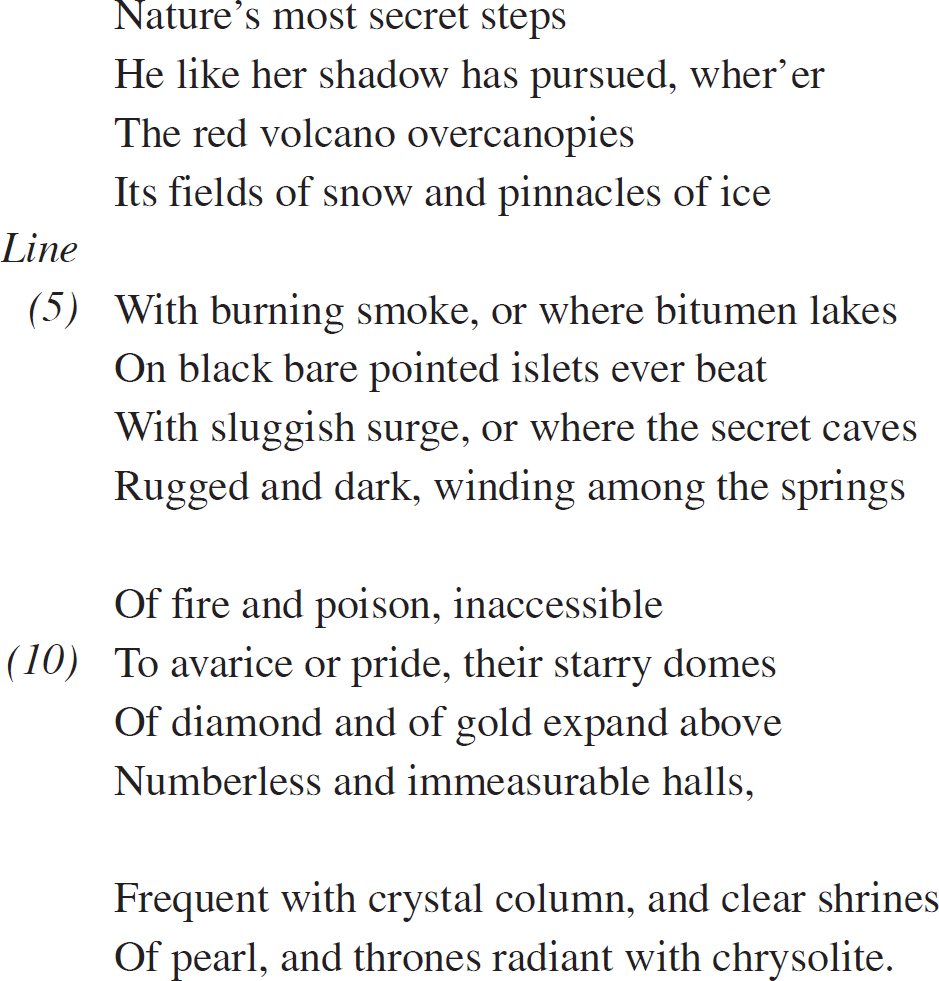
1. The word “inaccessible” (line 9) modifies which of the following words?
(A) “lakes” (line 5)
(B) “caves” (line 7)
(C) “springs” (line 8)
(D) “poison” (line 9)
(E) “avarice” (line 10)
You should recognize that inaccessible is an adjective (the ending -ible gives it away). That observation means that you need to decide which noun or pronoun it modifies. Unfortunately, all of the choices are nouns. If you look carefully, you will see that or (in line 7) introduces an independent clause. Because of the use of commas, the participial phrase winding among the springs modifies caves. Of fire and poison is a prepositional phrase modifying springs. To avarice or pride is another prepositional phrase that limits inaccessible. The correct answer, then, is (B), caves. Tough, isn’t it?
Try this poem by Emily Dickinson.
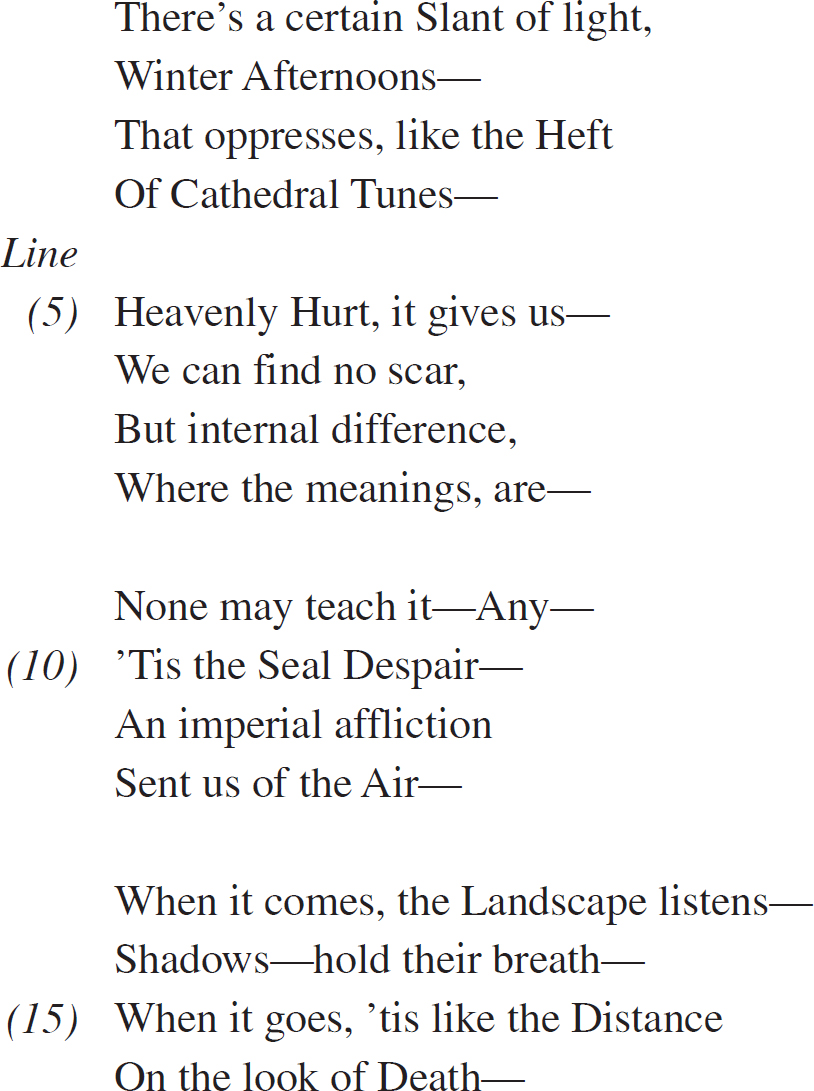
2. In line 5, “it” refers to
(A) “Cathedral Tunes” (line 4)
(B) “Heavenly Hurt” (line 5)
(C) “Slant of light” (line 1)
(D) “look of Death” (line 16)
(E) “imperial affliction” (line 11)
Asking what a pronoun refers to is a favorite of the AP Exam writers. Do you see that this isn’t so much a question of grammatical analysis as it is of comprehension? The correct answer is (C). The slant of light is the antecedent.
Suggested time: 12–15 minutes
Questions 1–13. Choose your answers to questions 1–13 based on a careful reading of the following poem by Phillis Wheatley.
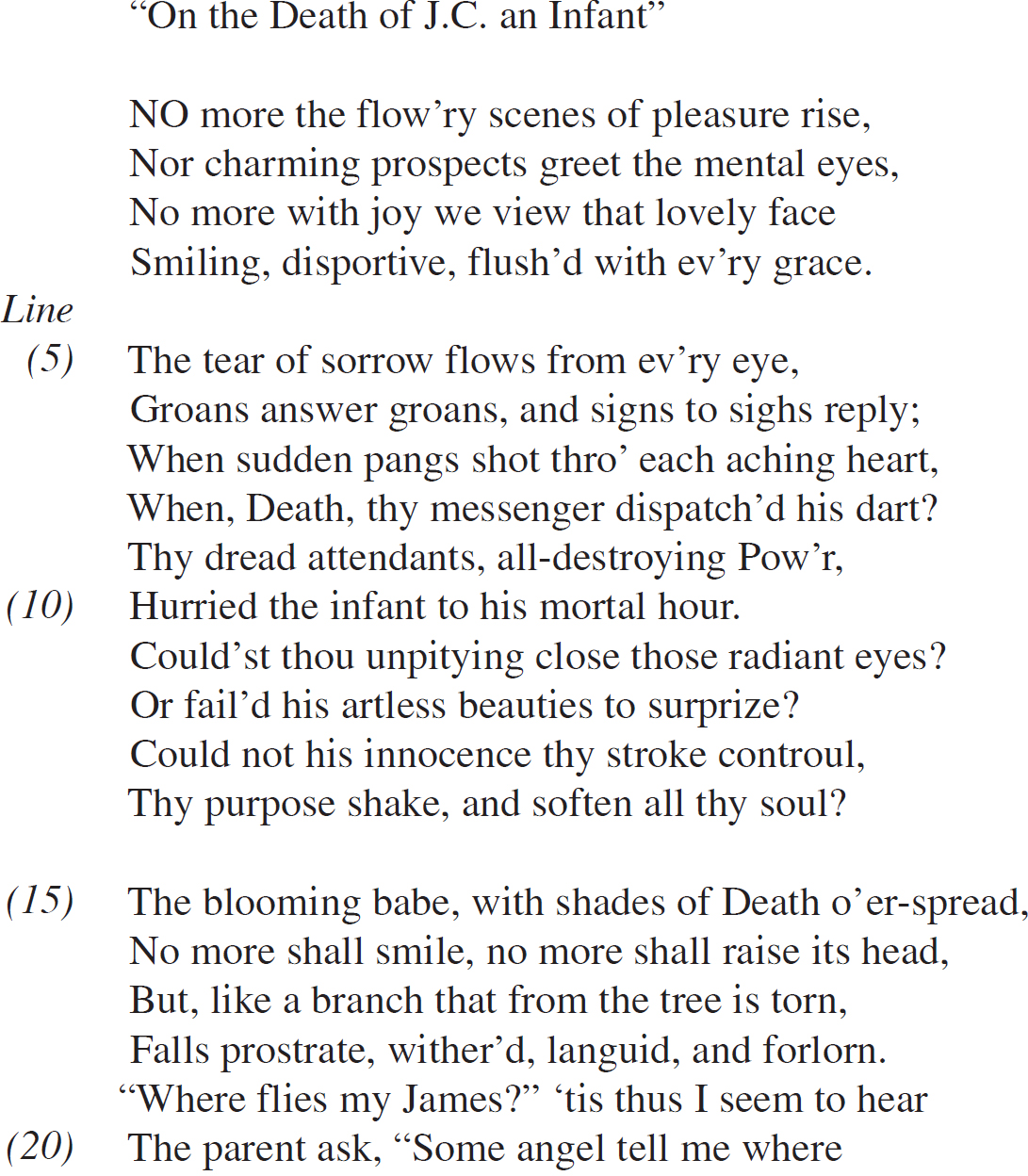
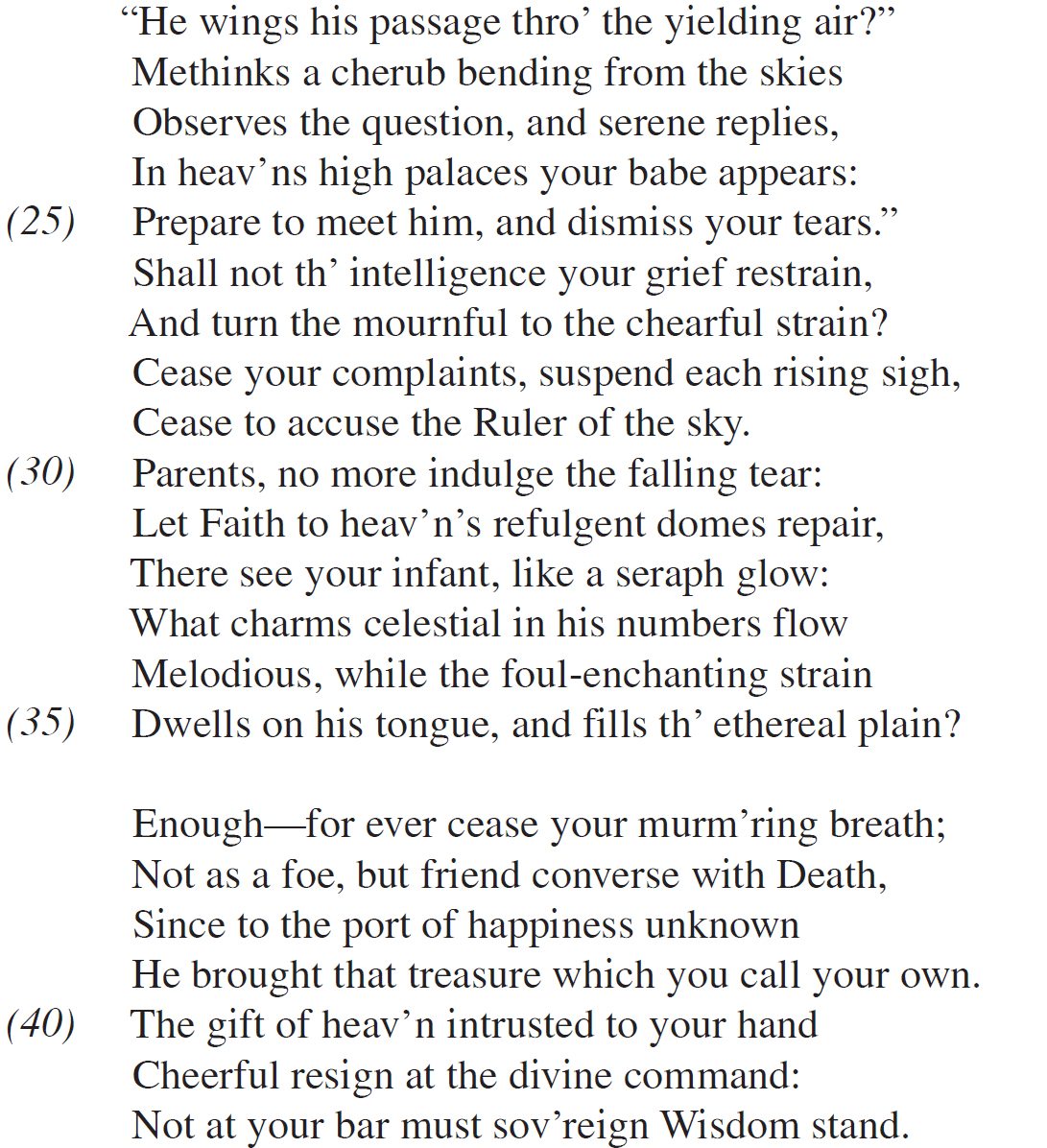
1. Taken as a whole, the poem is best understood to be
(A) an epitaph
(B) an elegy
(C) a parable
(D) a dirge
(E) a sestina
2. All of the following are speakers in the poem EXCEPT
I. Death
II. James
III. the parent
IV. a cherub
(A) I only
(B) I and II only
(C) II and III only
(D) III and IV only
(E) II, III, and IV only
3. The poet’s use of syncope throughout poem serves
(A) to save copying time, since this poet wrote in longhand
(B) to form alliteration with the surrounding words
(C) to make the line fit the poem’s meter
(D) to make it evident that a new subject is being addressed
(E) to represent the dialect of the speaker
4. Line 29 contains an example of
(A) an apostrophe
(B) an allusion
(C) free verse
(D) a metaphor
(E) a euphemism
5. The poet makes use of all of the following literary devices in lines 1–4 EXCEPT
(A) metaphor
(B) consonance
(C) iambic pentameter
(D) enjambment
(E) parallelism
6. Grammatically, the word “wings” (line 21) is a
(A) noun
(B) direct object
(C) adjective
(D) adverb
(E) verb
7. The tone in lines 1–21 is best characterized as
(A) disdainful
(B) nostalgic
(C) reverential
(D) woeful
(E) earnest
8. Lines 30–31 can best be paraphrased as
(A) “Dismiss your tears and return your faith to heaven”
(B) “Your tears are important: know that heaven will heal you”
(C) “The angels of heaven will mend the tears in your heart”
(D) “Your faith, not your tears, will replace the repugnant structures of heaven”
(E) “Parents, repair your faith so you too may see your infant in the vaults of heaven”
9. Each clause in lines 28–29 is best described as a
(A) question
(B) command
(C) concession
(D) invitation
(E) declaration
10. The primary purpose of lines 22–25 is to
(A) engage the listeners by offering a peaceful anecdote
(B) remind the parents they will see their infant in heaven
(C) recount the infant’s words to those left on earth
(D) console the grieving parents
(E) speculate where the infant has gone
11. In lines 13–14, “thy” refers to
(A) each aching heart
(B) the poet
(C) Death
(D) the attendants
(E) the infant
12. Lines 19–21 are notable for the use of which of the following?
I. A rhyming triplet
II. A change in the speaker
III. A change in punctuation
(A) I only
(B) I and II only
(C) I and III only
(D) II and III only
(E) I, II, and III
13. Which course of action would the speaker most wish the audience to take?
(A) Be resigned to the harsh realities of life
(B) Stop indulging in misery
(C) Understand the gift that has been sacrificed
(D) Accept that the loss of a child is inevitable
(E) Entrust the infant to a higher power
Sold into slavery at age seven, Phillis Wheatley was educated by her Boston slave owner and in 1773 became the first published African American poet. Her preferred poetic form was the couplet, and elegies comprised more than one-third of her published works.
1. B
This is a definition question. An elegy is a poem that mourns the death of someone, which makes the correct answer (B). None of the remaining answers would work. An epitaph is the inscription on a tombstone, so eliminate (A). A parable is a story that instructs, so (C) is also incorrect. A dirge is a song lamenting the dead, so (D) can be eliminated. A sestina has a different rhyme scheme and is only 39 lines long, so eliminate (E).
2. D
Pay attention to the word EXCEPT. The poem contains three speakers: the poet, the parent (lines 19–21), a cherub (lines 24–25), so eliminate (A), (B), and (C) since these choices do not include both (III) and (IV). Death never replies to any question asked of him—nearly every question in this poem is rhetorical. Finally, James (aka the infant—notice the title) never speaks; he is spoken about. The correct answer is (D).
3. C
This question is tricky if you don’t know the definition of syncope. Syncope involves the shortening of a word by removing internal letters and inserting an apostrophe. Poets often employ this technique, and Wheatley uses it frequently in this poem. By modifying the sound of certain words, the poet ensures that the line’s metrical rhythm is kept intact. The correct answer is (C).
4. B
This is another definition question. The use of the word Ruler makes this line an example of an allusion, specifically a biblical allusion as “Ruler” refers to God. Wheatley often wrote about her Christian faith in her poems, so it would not be surprising to find such allusions in her poems. The correct answer is (B).
5. A
One example of consonance, (B), in lines 1–4 is the repetition of the s sound (scenes, rise, prospects, smiling, grace). The poem is written in iambic pentameter, (C). The end of line 3 contains an example of enjambment, (D). Lines 1 and 3 contain parallel structure, (E). The device not appearing in these four lines is metaphor. The correct answer is (A).
6. E
Make sure to read the entire sentence, not just line 21. Start in line 20 at the beginning of the quotation: “Some angel tell me where He wings his passage thro’ the yielding air?” The word wings is not being used as a noun, as it is normally used. Eliminate (A) and (B). The parent is asking where the infant wings (or flies) through the air (i.e., where did he go?). Thus, the word wings is being used as a verb. The correct answer is (E).
7. D
Remember that this poem is an elegy. Elegies are written about someone who has died, so the tone is likely sorrowful. Lines 1–12, for example, confirm this. The poet expresses great sadness through the use of phrases like no more joy, tear of sorrow, Death, and Hurried the infant to his mortal hour. The tone is indeed sorrowful, which makes the best answer (D).
8. A
The meaning of the word repair in this context is to return to or to go to a place, not to fix something. Knowing that, eliminate (B), (C), and (E). If you know what repugnant means (repulsive), then eliminate (D), since there is nothing in these lines that suggest the “heav’n’s refulgent domes” are repulsive or offensive. (By the way, refulgent means “shining brightly.”) This leaves the correct answer, which is (A).
9. B
The three clauses begin with cease, suspend, and cease, which are all verbs in the imperative mood. The imperative mood is used when a speaker makes a command. In this poem, the speaker is requesting that the parents stop complaining about, sighing/crying for, and implicating God in the loss of their infant. There are no questions asked in these lines, so eliminate (A). The speaker doesn’t ask them to give up something—the parents have already lost something—in order to reach an agreement, so (C) is also incorrect. The speaker is not inviting the parents to stop, so eliminate (D). A declaration would fall under the indicative mood, and declaratives usually express statements and contain a subject, which is not the case in these lines; (E) is incorrect. The speaker is clearly making requests, so the best answer is (B).
10. D
With purpose questions, ask yourself why are these lines here, not what did the writer say. If you do the latter, you will likely pick (B) or (E), neither of which is the purpose of these lines. The speaker is offering the mourning parents solace and, to do so, offers them a peaceful thought: a cherub telling the parents their child is safe in heaven. Therefore, the speaker’s purpose is to comfort them. The correct answer is (D). These lines are not an example of anecdote, (A), and the words are that of the cherub, not the infant, (C).
11. C
The word thy is a possessive pronoun. When dealing with pronouns, you want to locate the antecedent. Whose stroke controlled? Whose purpose should be shaken? Whose soul should be softened? You will need to go back to line 8 to find the antecedent, which is Death. It is Death who hurried the infant to his mortal hour and with whom the speaker is pleading. The correct answer is (C).
12. E
Examine each item separately. Item (I) could be tricky. Note that the first eighteen lines contain nine pairs of couplets. Then hear seems to be alone while the couplet pattern continues until line 40, where the poem concludes with a triplet. There are eighteen lines between 21 and 40—eighteen lines that contain nine pairs of couplets. Thus, it’s likely that lines 19–21 form a triplet as well; in the spoken English of Wheatley’s time hear could have rhymed with where and air. Item (I) is valid. (Note: Even if you didn’t have time to notice that rhyme scheme, seeing that hear seems to break the couplet pattern should be enough to convince you to keep (I).) Eliminate (D). For (II), these lines indicate what the parent is asking, so there is a change in who is speaking. Eliminate (A) and (C). Finally, for (III), quotation marks are used for the first time, so there is also a change in punctuation—a change from anything used previously. Therefore, the correct answer is (E).
13. E
The speaker expresses the idea of God and Heaven several times. In the Christian faith, when a baby dies, he or she will go to heaven if baptized. The speaker, in an effort to comfort the grieving parents, is reminding them of this and urging them to put their faith in God. Choices (A), (B), and (D) are all too negative and do not align with the message of the speaker. While the speaker does acknowledge the sacrifice, the takeaway message is more than their sacrifice—it is to hold fast to their faith in God.
Suggested time: 12–15 minutes
Questions 1–11. Choose your answers to questions 1–11 based on a careful reading of the following poem by Carl Sandburg.
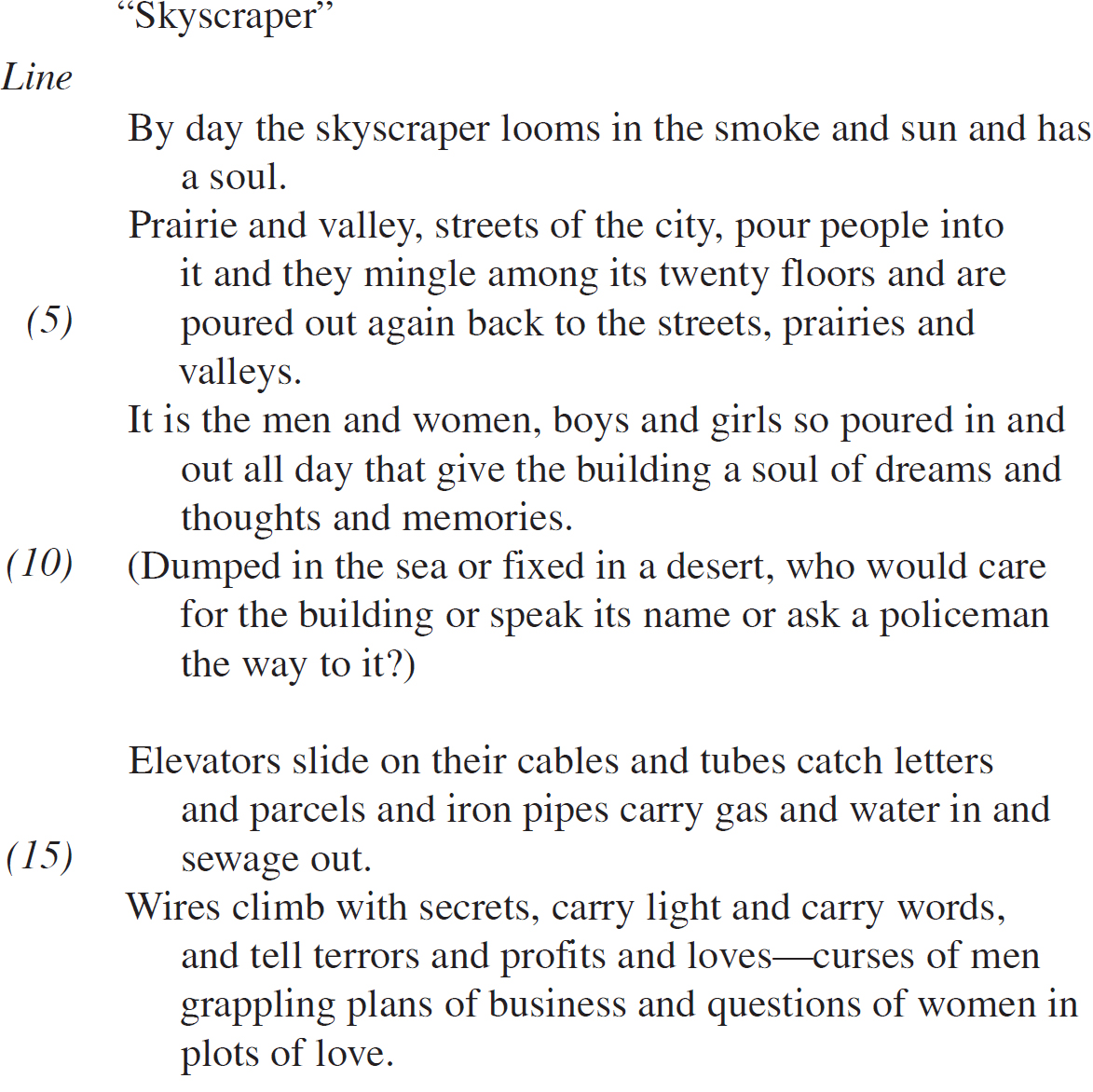
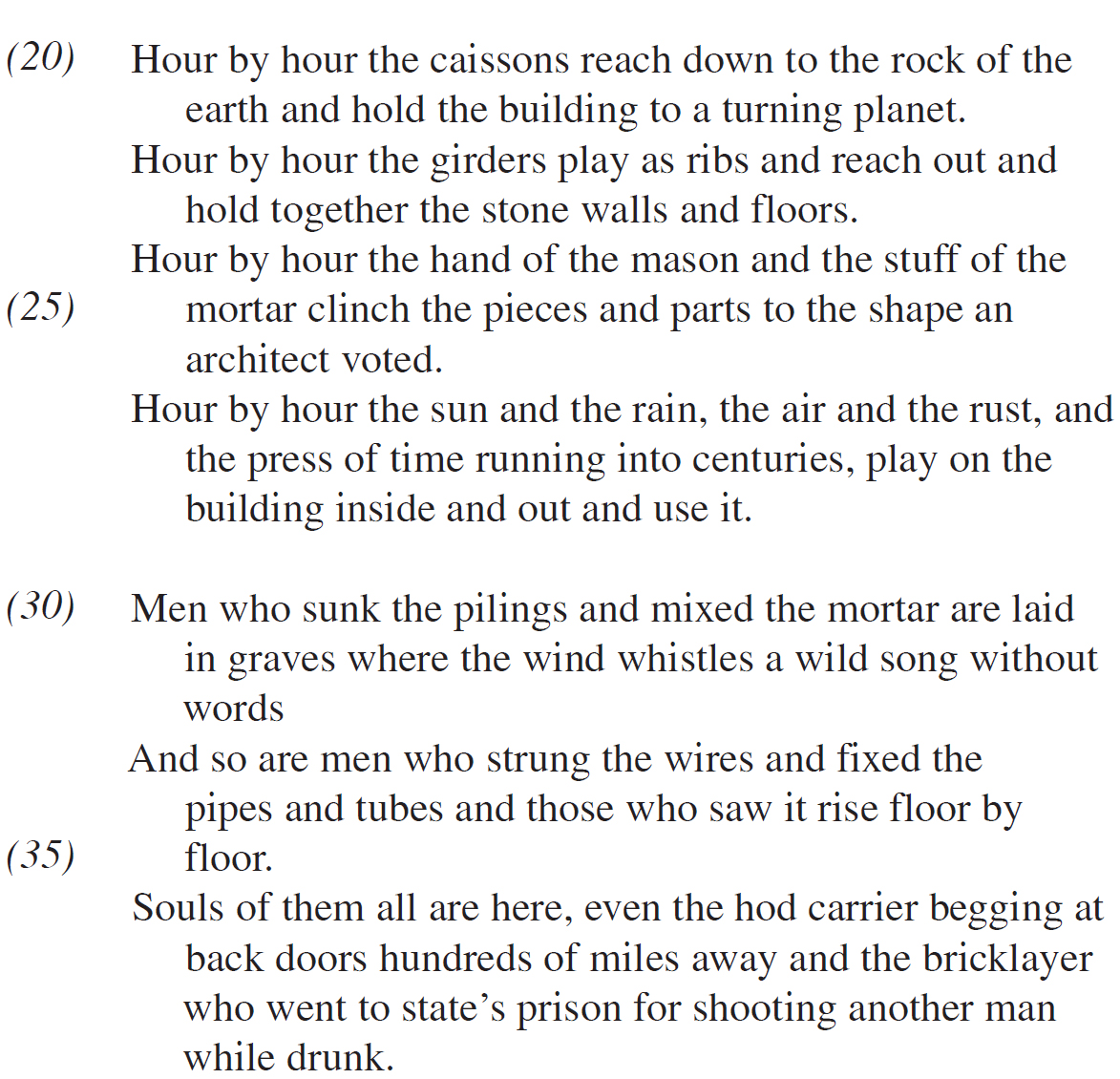
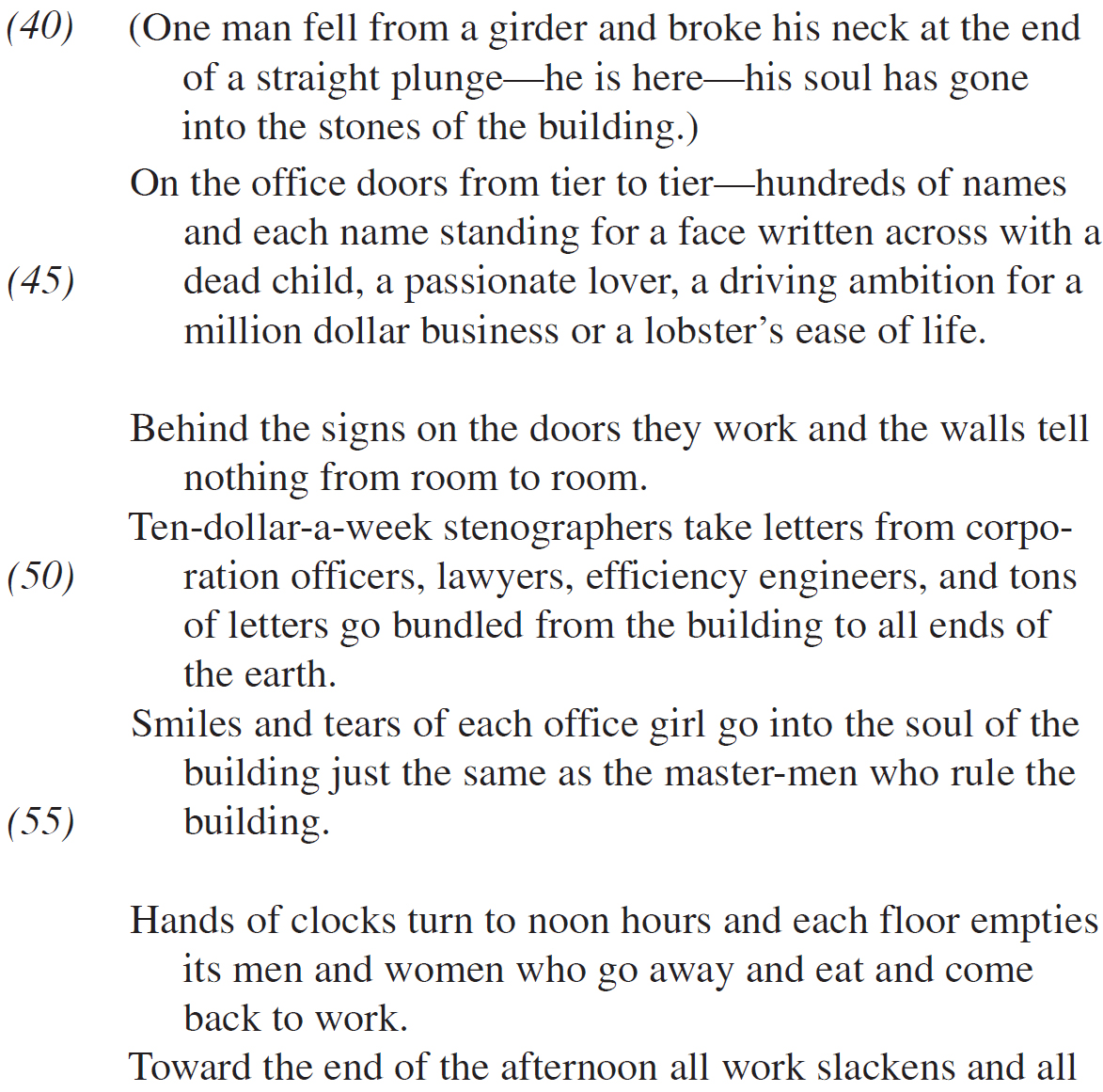
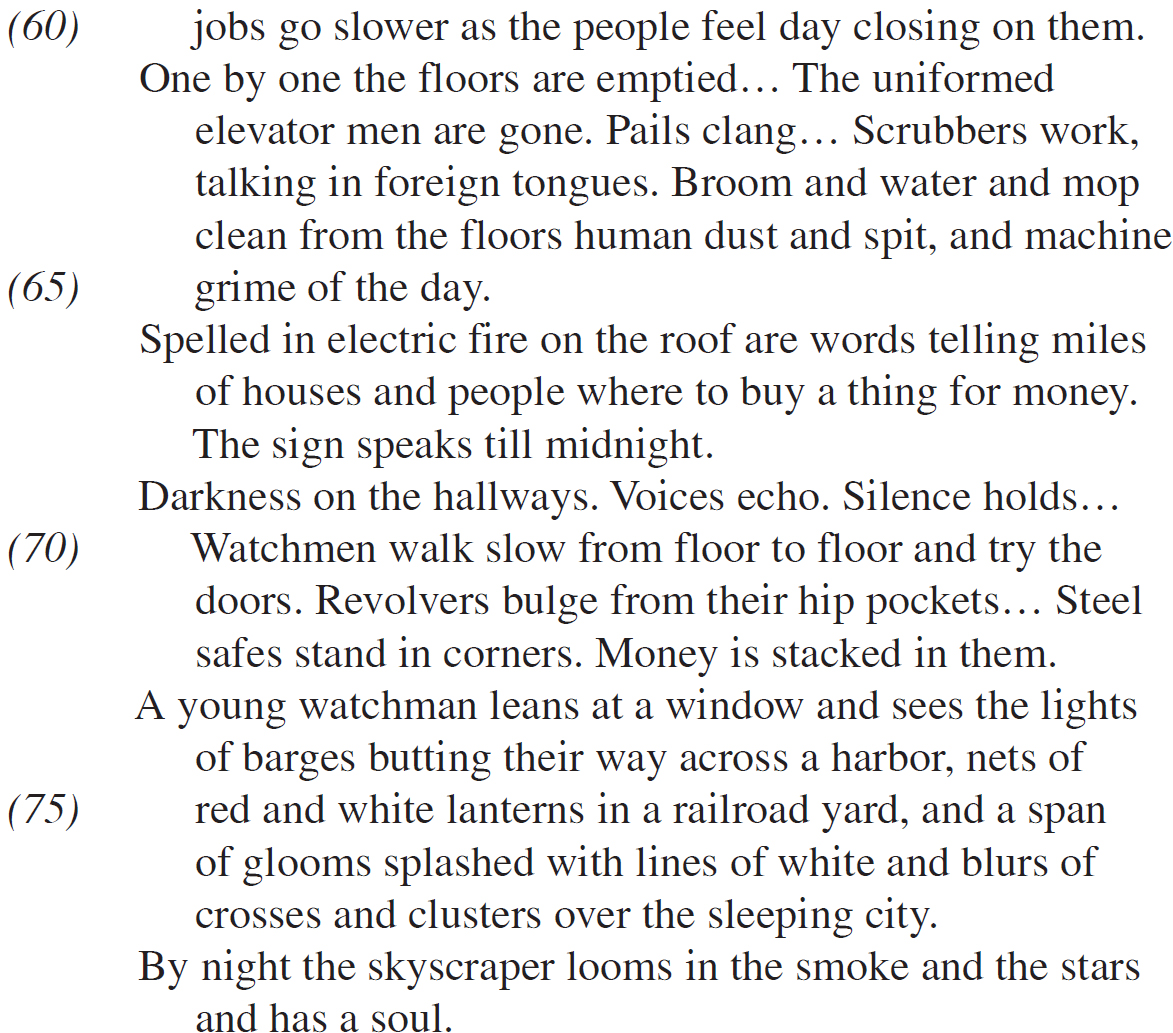
1. What is implied by lines 10–12 (“Dumped…to it”)?
(A) The building depends on people.
(B) It would be just as easy to tear down the skyscraper and dump its bricks and mortar and steel girders as it is to let it stand.
(C) The skyscraper is important only because of the city in which it is located.
(D) There would be no point in having the building unless people used it.
(E) The speaker doesn’t think the building has any value.
2. It can be inferred that the poet
(A) admires the workers who built the skyscraper
(B) would prefer it if the skyscraper were gone
(C) works in the skyscraper or in a building much like it
(D) venerates the skyscraper
(E) is critical of the contemporary social order
3. What is the significance of the description in lines 44–46 (“each…life”)?
I. It implies that each man is an individual, despite the sameness of their office doors with the names.
II. It points to the ruthless nature of the senior men working in the skyscraper.
III. It suggests that the executives in the offices are essentially all the same.
(A) I only
(B) II only
(C) I and III
(D) II and III
(E) I, II and III
4. The image in line 28, “the press of time running into centuries,” suggests
(A) the speaker’s attitude of awe for the building
(B) one of the poem’s themes
(C) the central metaphor of the poem
(D) an allusion to the city itself
(E) the negative quality of the building
5. According to the poem, which of the following is NOT true of the skyscraper?
(A) It has outlasted its original creators.
(B) It carries advertising messages to surrounding residents.
(C) It is permanent but not eternal.
(D) It is empty at night.
(E) It has systems that mirror those of a living being.
6. How do the first and last lines contribute to the structure of the poem?
(A) They reinforce the fact that the skyscraper has a soul.
(B) They give the poem a formal, “bookended” quality, stating and then restating an image.
(C) They reinforce the theme of time passing while the skyscraper endures.
(D) They present the skyscraper’s connection to major objects in the universe.
(E) They paint a vivid picture of the building’s enduring nature.
7. What can you infer from the poet’s diction?
(A) His intended audience was ordinary people, like the blue-collar construction workers, the watchmen and the “ten-dollar-a-week stenographers” (line 49) in the poem.
(B) He was writing primarily for men.
(C) He was accustomed to writing novels and short stories, not poetry.
(D) He wanted his writing to appeal to the “the master-men who rule the building” (lines 54–55), the “corporation officers, lawyers, efficiency engineers” (lines 49–50).
(E) He didn’t have much formal education.
8. In line 22, the statement that “the girders play as ribs” is an example of which literary device?
(A) An allusion
(B) A double entendre
(C) A simile
(D) Pathos
(E) Hyperbole
9. The narrator’s most likely reason for mentioning “the bricklayer who went to state’s prison for shooting another man while drunk” (lines 37–39) is
I. to show that the workers who built the skyscraper have human vices and frailties.
II. to emphasize the contrast between the construction workers who built the skyscraper and the white-collar executives who work there now.
III. to give an individual identity to at least one of the faceless workers “laid in graves where the wind whistles a wild song without words” (lines 30–32).
(A) II only
(B) I and II
(C) III only
(D) II and III
(E) I and III
10. The watchmen, the office girls, the night cleaners and the construction workers have all of the following characteristics in common EXCEPT
(A) They are enablers.
(B) They won’t outlast the skyscraper.
(C) They won’t end up in an office with their name on the door.
(D) They give the building its soul.
(E) They are proud of their association with the building.
11. Which of the following best summarizes the significance to the poem of lines 16–19 (“Wires…love”)?
(A) Just as the skyscraper gives people a place to work, so the telephone lines give them a way to make plans to achieve what they want.
(B) It reinforces the poet’s assertion that it is the people using the skyscraper who give it life and soul.
(C) The telephone wires in the skyscraper may be inanimate, but they carry dramatic conversations and plans for action.
(D) Although the stenographers are faceless and the executives are behind identical doors on identical floors, these people are not bland and ordinary. Their lives are filled with secrets and intrigue and ambition.
(E) It explains what is hinted at in lines 47–48: “Behind the signs on the doors they work and the walls tell nothing from room to room.”
Skyscrapers—a solution to the shrinking amount of land in big city downtown areas—were still a relatively new phenomenon when American poet Carl Sandburg wrote this in 1916. The Wainwright Building in St. Louis, built only 25 years earlier, is often considered the first such building. They were called “skyscrapers” because, in comparison to the surrounding buildings, they were tall enough to scrape the sky.
1. A
Remember, when a question stem sends you to a specific line in a poem, always read at least a line before and a line after in order to understand the context. If you looked only at lines 10–12, you might think the correct answer is (C). In this case, you only need to read one line before—“It is the men and women, boys and girls so poured in and out all day that give the building a soul of dreams and thoughts and memories”—to see that the correct answer is (A). The skyscraper has value and permanence and a sense of life in virtue of the people who work in it and maintain it and consider it important, not because of the city in which it stands. Choice (D) is too narrow—people do more than use the building. Choices (B) and (E) aren’t implied: the speaker doesn’t suggest that dumping the skyscraper in the sea would be easy, and doesn’t give his own opinion of the building’s value.
2. E
This question calls for two things: an understanding of the poem as a whole, and an ability to distinguish the poet from the narrator. The first requirement eliminates (C)—there is much more to the descriptions in the poem than an obvious familiarity with the day-to-day routine of working in a downtown office building. Choice (A) is gone for the same reason—the original construction crew is only one of the groups of people the poet describes. In addition, there is no suggestion that he particularly admires them. The poet’s tone is too neutral to suggest either hostility, (B), or veneration, (D), for the building, so eliminate those two choices. That leaves (E). He juxtaposes the “Ten-dollar-a-week stenographers” (line 49) and “the master-men who rule the building” (lines 54–55). He states that, at night, “Scrubbers work, talking in foreign tongues” (lines 62–63) and refers to the blue-collar workers who erected the building so white-collar “corporation officers, lawyers, efficiency engineers” (lines 49–50) could work there. The poet is suggesting a criticism of the class system and gender inequality of his time. Although the narrator’s tone is relatively neutral when he refers to these groups, it is the author who chose to include them in the poem.
3. E
Here’s the Roman numeral format, so approach it first as a standard format question with only three choices. What about Statement (I)? That’s true; each man has something unique in his personal life, whether it’s a “dead child” or “a passionate lover.” Statement (II) is also true; each man has a “driving ambition” for wealth. And Statement (III) is true; although the men’s personal lives and ambitions are unique, they each have those things, in addition to their identical “office doors from tier to tier” (line 43). Each executive is one of “the master-men who rule the building” (lines 54–55).
Now look at the lettered choices. Which one includes all three Roman numeral answers? That’s (E).
4. B
POE works well on this question. The quoted phrase is neither a metaphor nor an allusion, so (C) and (D) can be eliminated. When you read the line before and after, there is no mention of the speaker’s opinion, which eliminates (A). The only negative word in line 27 is “rust”; otherwise the description is neutral, so (E) can also be eliminated. That leaves (B) and indeed, when you consider the poem as a whole, one of the themes running through it is time. For example, the builders ended their short lives long ago, but the skyscraper they constructed still stands. “Hands of clocks turn” (line 56); day turns into night turns into day. The skyscraper “has a soul” (lines 1 and 79), which is eternal.
5. D
In this EXCEPT/LEAST/NOT format question, first eliminate the “NOT,” leaving the standard format question, “which of the following is true of the skyscraper?” Then eliminate the four choices that would be correct answers to that question. Choices (A) (lines 30–32), (B) (lines 66–67), and (E) (lines 22–23) are all true of the building. So is (C)—the skyscraper may be anchored to the planet (lines 20–21), but time and weather are wearing it down (lines 27–29). It is “permanent” compared to the long-gone men who built it, but not “eternal” as the sun and stars are. That leaves (D) as the correct answer. Scrubbers (line 62) and watchmen (line 70) work in the building at night, so it is not empty. This is the only statement that is NOT true of the building.
6. B
The key words in the question stem are “contribute to the structure.” This is an example of how reading the question stem carefully, word for word, pays off. All of the answer choices are true of the first and last lines, but only one concerns the poem’s structure. That’s (B). The first line presents the skyscraper and its soul, looming “in the smoke and sun.” The poem then goes on to develop the building’s relationship to people, past and present, and its own life-like qualities. Then the last line returns to recap the first line; the building and its soul now loom “in the smoke and the stars.”
7. A
This question asks you to assess the poet’s vocabulary and choice of words throughout the entire poem, then make an inference from your assessment. What do you see in the language he chooses? Is it dominated by sophisticated words that only well-educated people would understand? No, so you can eliminate (D). Is it filled with lyrical references to dewdrops and cherubs? Is it overflowing with symbols and imagery and obscure references to ancient Greek gods? No – Sandburg uses concrete, down-to-earth, everyday language. Even words that seem unusual now (“caissons,” or foundations, and “hod carrier,” or a low-level laborer who brought supplies to tradesmen) were common in 1916. That accessible vocabulary points to ordinary, everyday people as his intended audience (A). The poet doesn’t describe many women (only the office girls in line 53 and possibly the stenographers in line 49 and the scrubbers in line 62). However, that’s not surprising; in 1916 men held most of the jobs. Nothing in the choice of language seems particularly aimed at either men or women, eliminating (B). The unrhymed free verse in this poem might make (C) seem like an attractive choice. However, the question asks about diction, not about poetic form, so (C) is incorrect. Using plain, everyday language doesn’t necessarily point to a lack of formal education, (E). In fact, Sandburg did attend college and West Point, although the progression of his education was erratic. Therefore, you can eliminate (E).
8. C
A simile compares two unlike things (here, inanimate steel girders and living ribs of bone), using “as” or “like.” This particular simile reinforces the concept of the skyscraper having life. None of the other choices would apply to the quote in the question stem. An allusion, (A), is a brief reference to a significant person, place or thing (such as a character in a Shakespearean play, or a place in a Greek myth). It depends on readers being familiar with the reference. A double entendre, (B), refers to a word or statement which can be interpreted in different ways. It is often used for humor or irony. Pathos, (D), is designed to trigger feelings of pity or sympathy in the reader. Hyperbole, (E), is an exaggeration intended to create emphasis.
9. C
The question stem asks for the “most likely reason,” singular, so unless two of the Roman numeral choices say virtually the same thing in different words (which they don’t), you’re looking for only one answer. That eliminates (B), (D) and (E). Statement (I) must be incorrect because it’s not mentioned in the remaining choices, (A) and (C). Nothing in the description of the white-collar executives suggests that they wouldn’t be equally capable of getting drunk and shooting someone, so you can eliminate (II). That leaves (III) and makes (C) the correct answer.
10. E
This is a tricky question that requires careful reading of the question stem. It says these four groups “have” characteristics in common—not “likely have” or “probably have.” This stem isn’t asking for inference or interpretation; it allows for only what the poem directly and specifically says.
Since this is an EXCEPT/LEAST/NOT format question, cross out the EXCEPT and find the four answer choices that would be correct for the resulting standard format question. Choice (A) is correct: the construction workers enabled the skyscraper to exist, the office girls enable to executives to send out their letters, the night cleaners enable workers to return the next day to an environment free of “human dust and spit, and machine grime” (lines 64–65), and the watchmen with their revolvers enable protection from intruders and from thieves who want the money in the steel safes. The construction workers didn’t outlast the skyscraper they built; none of the other human groups will outlast it, either, so (B) is correct. Only the members of the privileged class—the “corporation officers, lawyers, efficiency engineers” (lines 49–50)—get an office with their name on the door. In the poet’s 1916 class society, no one from the other four groups would have that chance, so (C) is correct. Choice (D) is correct; the building has a soul in virtue of the “[men and women]…poured in and out all day” (line 5) and the workers who built it (lines 30–32), while the scrubbers and watchmen who take over at night, after the “floors are emptied” (line 61), give the skyscraper its soul in the stars (lines 69–70). That leaves (E) as the correct EXCEPT answer. The narrator is neutral about the relationships between each of the four groups and the building. They may be proud of their association with it; they may not be. From what the poem says, we don’t know, and the question stem doesn’t allow inferences.
11. B
Again, careful reading of the question stem is essential. You’re asked about the significance of lines 16–19 to the poem, not about what the words mean (C) or what the poet might be implying (D). Those two choices are both incorrect. Choice (E) has some merit in presenting lines 47–48 as an expansion. However, it’s too narrow. The question asks for the best summary of the significance to the poem as a whole, not just to part of it. Choice (A) is also too narrow; it misses the connection between the life of people and the soul of the skyscraper that runs throughout the poem. Only (B) makes that connection.
Don’t worry about scansion (you know: iambic pentameter, dactyls, spondees, and the like). You probably won’t see even one question on it.
Remember:
Read the poem as prose.
Focus on the main idea.
When answering the questions, use POE and Consistency of Answers.
Be sure to read around line references.
Metaphysical poetry is excellent practice for the kind of poetry you’ll see on the AP Exam. John Donne, Andrew Marvell, George Herbert, Thomas Carew, Abraham Cowley, and Richard Crashaw are all poets whose work provides excellent AP practice. Also, the poetry of Emily Dickinson and Robert Frost is rich in intricate grammatical structures.
On EXCEPT, NOT, and LEAST questions, cross out the negative word and eliminate any choice that fits the remaining question.
Respond to the following questions:
Of which types of multiple-choice questions discussed in this chapter do you feel you have achieved sufficient mastery to answer correctly?
On which types of multiple-choice questions discussed in this chapter do you feel you need more work before you can answer correctly?
What strategies discussed in this chapter do you feel you will be able to apply effectively when taking the exam?
What parts of this chapter are you going to re-review?
Will you seek further help, outside of this book (such as from a teacher, tutor, or AP Students), on any of the content in this chapter—and, if so, on what content?